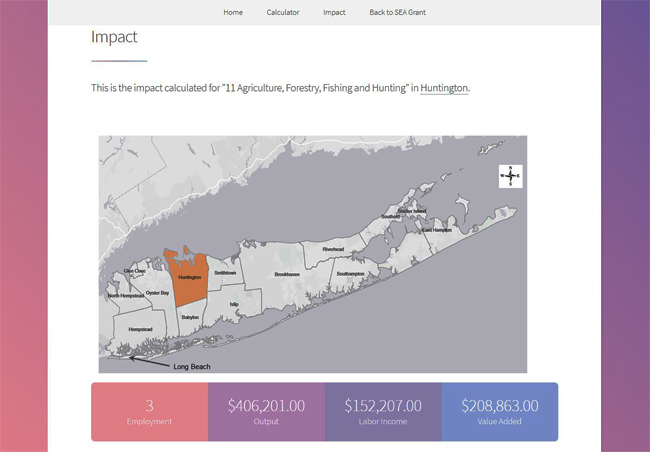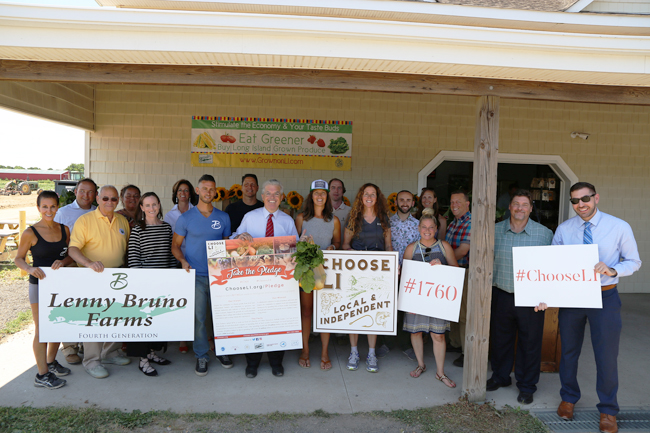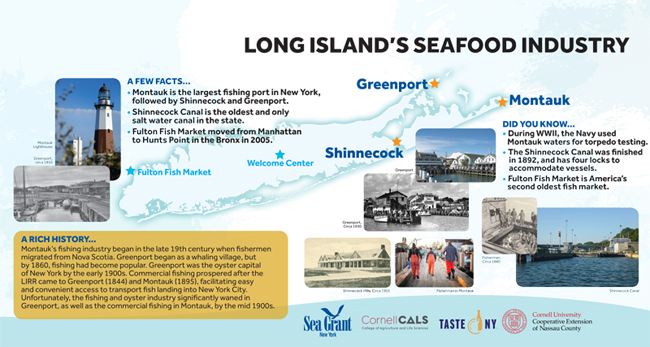— By Chris Gonzales, Freelance Science Writer, New York Sea Grant
Farmingdale, NY, December 10, 2018 - The “ocean economy” of Long Island generates approximately $2.4 billion in economic activity, or 1.4% of the region’s gross domestic product, the sum of all economic activity, of $170 billion.
If investments are made in marketing, boats, train links, piers, and other infrastructure, the region could see a 3% to 5% increase in tourism and stimulate recreational fishing demand. Employment and output in the recreational fishing-related sectors on Long Island could increase by 3.1% and 3.2% respectively.
Coastal industries added 9,744 jobs from 2005 to 2014, for a total growth of 24.9%.
These new insights, funded by New York Sea Grant and gathered by Farmingdale State College’s Business and Economic Research Center, come from a new, three-year economic study. The researchers have published several scholarly papers in economic journals, most recently in the Academy of Economics and Finance Journal1.
In addition, the researchers gathered findings from 20 Long Island coastal areas, bringing in details from over 700 respondents to a visitor survey.

A new economic calculator estimates potential
gains and losses from investment in Long Island's coastal communities.
The tool was created through a NYSG-funded project by Farmingdale State
College's Richard Vogel. NYSG's Fisheries Specialist Antoinette
Clemetson coordinated a roundtable discussion in October to engage
representatives from the fishing industry. The new tool is targeted for
use by local chambers of commerce and other tourism-related entities.
Leaders of the research team and various stakeholders discussed the findings in a meeting held on October 11, 2018. The meeting included representatives from government and industry fishing regulatory bodies and economic development officials.
Richard Vogel, dean of the School of Business and an economics professor at Farmingdale State College, is the center’s director.
“This event reminds regional community and business leaders of the interrelationship between the marine economy and the greater Long Island economy,” said Vogel. “Long Island’s fisheries help to support and sustain over $5.5 billion in tourism spending which drives additional economic activity in the community.”
Vogel and his team have created a free online tool, an economic impact calculator designed to estimate potential growth from investments in infrastructure and marketing in the region.
Antoinette Clemetson, fisheries specialist at New York Sea Grant, said it is unusual and a special occasion for her organization to invest in an economic study. Much of its work involves biological research, outreach, and promoting stewardship of coastal resources.
“Fishermen and women often voice concerns about the potential impacts of new regulations on their businesses,” said Clemetson. “Now we can use this economic impact calculator to simulate potential losses and gains in coastal economies.” Clemetson added that the tool can be applied beyond the fishing and agriculture sector to answer questions for different townships across Long Island.
In 2015, Vogel’s team of researchers and student assistants began collecting economic data on Long Island and its marine economy. They developed an economic simulation based on those data.
Realizing that alternative policy decisions might affect goods and services in the ocean economy, the team focused particularly on fishing — both recreational and commercial — and coastal tourism.
The researchers developed an economic map of Long Island’s tourism and hospitality industry. It included features such as fishing spots, shopping centers, boat tours, hotels and RV parks, restaurants, and access to train stations.
Recreational fishing does contribute significant value to the region’s economy, they found. Improving offerings such as recreation trails, piers, and train links between destinations could support economic growth, while respecting regulations that protect fish and water quality.
“We are excited to have supported this project that examines the roles of coastal tourism and fishing in our local and regional economies, and identifies them both as areas for growth,” said Kathy Bunting-Howarth, interim director of New York Sea Grant. “The coastal environment and economy go hand in hand.”
In the future, Vogel and his team would like to conduct an annual survey to monitor the ocean economy. In addition, they would like to study economic effects in smaller coastal towns.
Among other findings discussed at the meeting:
- Majority of non-residents felt that Long Island needs more tourist hotels.
- Residents and non-residents both indicated that they would like to see more nightlife on Long Island, followed by concerts, and food and drinks.
- There are 32,000 jobs in Suffolk County in ocean-related economy, 5% of all total jobs, generating $1 billion in goods and services.
Vogel said the ocean economy is centered on commercial and recreational fishing but includes tourism-related businesses in coastal areas, such as restaurants, hotels, stores, marinas, campgrounds, parks and museums.
According to Pat Augustine of the Atlantic States Marine Fisheries Commission, the Atlantic states have very well-regulated fisheries. He gave the example of reduction of harm to sharks harvested for their fins and tossed back in a helpless state to feed the market for shark fin soup. A successful intervention has greatly reduced the practice. He added that foreign fishing vessels are not allowed within 200 miles from shore.
“Who are the next generation of fishers and farmers going to be?” asked August Ruckdeschel, an economic development specialist for Suffolk County. He said the current federal administration appears to be supportive of sustainable ocean-based fish farm growth, now virtually non-existent in the United States.
Ruckdeschel manages a website about agricultural and fishing interests.
“The U.S. imports the fish we eat, and exports the fish we catch,” Ruckdeschel said. “We’re trying to change that, change consumer tastes, much the way monkfish was transformed from a trash fish to a desirable fish.”
References
1 Li, S., R. Vogel and N. Viswanathan. “Impact of Recent Shocks on Long Island’s Tourism: A CGE Model.” Academy of Economics and Finance Journal 8: 33-42. 2017
Li, S., R. Vogel and N. Viswanathan. “Economic Growth and Revitalization on Long Island: The Role of the Recreational Fishing and Marine Economy.” Academy of Economics and Finance Journal 7:29-34. 2016

This past summer, Suffolk County Executive Steve Bellone announced the launch of ChooseLI.org, a collaborative effort that seeks to raise awareness, advocate and inspire the community to support local and independent businesses on Long Island. More at “Sea Grant Partners For ChooseLI.org Launch.” Credit: Suffolk County Executive Steve Bellone.

This past summer, NYSG supported the local tourism industry in another way, by partnering with CCE Nassau County to organize an information desk — available throughout July to distribute information about local seafood choices and seafood production — at The Long Island Welcome Center. The center, at eastbound Exit 51-52 on the Long Island Expressway, opened on Oct. 20, 2016 and reportedly welcomes nearly 8,000 people a day. “Tourism and agriculture are critical drivers of the Long Island economy and with the new Welcome Center, we are making smart investments to support these industries throughout the region,” said New York Governor Andrew Cuomo. For more posters from this effort, see "NYSG Summer 2018 Intern Encourages Support for Local Fishing Businesses." Credit: Design by Loriann Cody.
More Info: New York Sea Grant
New York Sea Grant (NYSG), a cooperative program of Cornell University
and the State University of New York (SUNY), is one of 33 university-based
programs under the National Oceanic and Atmospheric Administration’s
National Sea Grant College Program.
Since 1971, NYSG has represented a statewide network of integrated
research, education and extension services promoting coastal community
economic vitality, environmental sustainability and citizen awareness
and understanding about the State’s marine and Great Lakes resources.
Through NYSG’s efforts, the combined talents of university scientists
and extension specialists help develop and transfer science-based
information to many coastal user groups—businesses and industries,
federal, state and local government decision-makers and agency managers,
educators, the media and the interested public.
The program maintains Great Lakes offices at Cornell University, SUNY
Buffalo, SUNY Oswego and the Wayne County Cooperative Extension office
in Newark. In the State's marine waters, NYSG has offices at Stony Brook
University in Long Island, Brooklyn College and Cornell Cooperative
Extension in NYC and Kingston in the Hudson Valley.
For updates on Sea Grant activities: www.nyseagrant.org has RSS, Facebook, Twitter, and YouTube links. NYSG offers a free e-list sign up via www.nyseagrant.org/nycoastlines for its flagship publication, NY Coastlines/Currents, which is published quarterly. Our program also produces an occasional e-newsletter,"NOAA Sea Grant's Social Media Review," via its blog, www.nyseagrant.org/blog.